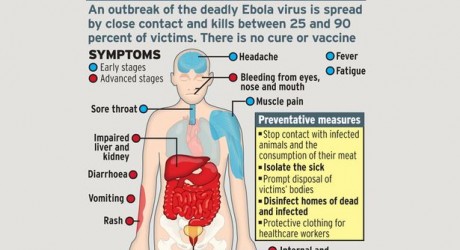The Ebola outbreak in Nigeria appears to be nearing a possible end due to a rapid response coordinated by Nigeria’s Emergency Operations Center with assistance from international partners, including the Centers for Disease Control and Prevention. The official end to an Ebola outbreak comes when two of the 21-day incubation periods for Ebola virus have elapsed without any new cases.
During the outbreak, there were 19 laboratory-confirmed and one probable Ebola cases in two Nigerian states. Nearly 900 patient contacts were identified and followed; all but three have completed 21 days of follow-up period without Ebola symptoms. There have been no new cases since August 31 and the last three patient contacts will exit their 21-day follow-up on October 2 – strongly suggesting the outbreak in Nigeria has been contained. A report on Nigeria’s response to the outbreak appears in a September 30 early release issue of CDC’s Morbidity and Mortality Weekly Report (MMWR).
“Although Nigeria isn’t completely out of the woods, their extensive response to a single case of Ebola shows that control is possible with rapid, focused interventions,” said CDC Director Tom Frieden, M.D, M.P.H. “Countries throughout the region as well as Nigeria need to take rapid steps to prepare for possible cases of Ebola in order to prevent outbreaks in their country.”
On July 20, 2014, a very sick traveler from Liberia arrived at the international airport in Lagos, Nigeria, a densely populated city of 21 million and a regional hub for economic, political, and travel. By the time it was recognized that the patient carried the Ebola virus, he had exposed 72 people on commercial aircraft, at an airport, and at a hospital. It appeared that conditions were ripe for the disease to spread through the city, the nation, and perhaps to other parts of Africa and beyond.
Nigerian authorities took several quick actions. Nigeria’s Port Health Services began contact tracing at the airport and worked with airlines and partners to ensure outbreak notifications were made according to International Health Regulations established by the World Health Organization. Nigeria’s Ministry of Health activated an Ebola Incident Management Center (a precursor to its current Emergency Operations Center) and charged it with leading the national response; that center was led by an incident manager chosen for experience and competency.
Nigeria established its incident management system in October 2012 as part of its emergency plan for the global polio eradication initiative. Overall design of the Ebola response came from a senior strategy team that included international partners, including Doctors Without Borders, UNICEF, CDC, and WHO. Among its activities, the team developed a staffing plan that executed a social mobilization strategy that reached more than 26,000 households of people living around the contacts of Ebola patients.
Nigeria’s decision to use the emergency operations center to respond to the Ebola outbreak resulted in a rapid, effective and coordinated response, according to the MMWR.
Ebola Importation and Containment – Senegal, 2014
Due to national preparedness and prompt cross-border communication, Senegal avoided an Ebola epidemic after confirming its first case of the disease on August 29, 2014.
On August 14, a man traveled in a seven-person taxi from Guinea to the densely populated city of Dakar, Senegal to visit his family. He fell ill two days later with fever, diarrhea, and vomiting and sought care at a neighborhood clinic, where he was treated as an outpatient – receiving intravenous fluids and other symptomatic care until he was admitted to a Dakar hospital on August 26.
The patient did not tell anyone that his brother had died in Guinea on August 10, and that he had helped his family prepare the body for burial. The same day that the patient entered hospital in Dakar, his mother and sister were admitted to an Ebola Treatment Unit in Guinea, they named the patient as a contact. Public health staff contacted the Senegal hospital on August 27; he was promptly isolated and a blood sample was taken. On August 29, testing by Pasteur Institute Dakar confirmed that the man had Ebola virus disease.
The Senegal Ministry of Health had been preparing for just such a situation. Health care staff was already trained about Ebola virus and infection control. An oversight committee organized laboratory testing, case investigation, and contact tracing.
Investigation quickly identified 67 contacts of the Ebola patient – 34 residents of the home where he stayed, and 33 health care workers. All contacts underwent a 21-day monitoring period beginning on August 29; contacts were asked to submit to voluntary in-home quarantine and twice-daily temperature checks by Red Cross volunteers. Food was provided for all household contacts. On day one of monitoring, more than half of contacts were seen; by day five more than 90 percent of contacts had been seen.
By September 18 all 67 contact had completed the 21-day follow-up. There were no further confirmed cases of Ebola.
Prompt notification of health officials in Senegal about the case by health officials in Guinea, and early preparations by the Ministry of Health and partners in Senegal for anticipated imported cases of Ebola resulted in a rapid containment response, cording to the MMWR. The report also found that it is important for neighboring countries to anticipate imported cases and define success as containment rather than exclusion of imported Ebola cases. (CDC)
- Home
- News
- Views
- Opinion
- Editorial
- Features
- Clinical
- Regions
- Anguilla
- Antigua and Barbuda
- Bahamas
- Barbados
- Belize
- Bermuda
- British Virgin Islands
- Cayman Islands
- Dominica
- Grenada
- Guyana
- Jamaica
- Montserrat
- Saint Kitts and Nevis
- Saint Lucia
- Saint Martin
- Saint Vincent and the Grenadines
- Saint-Barthélemy
- Trinidad and Tobago
- Turks and Caicos Islands
- US Virgin Islands














